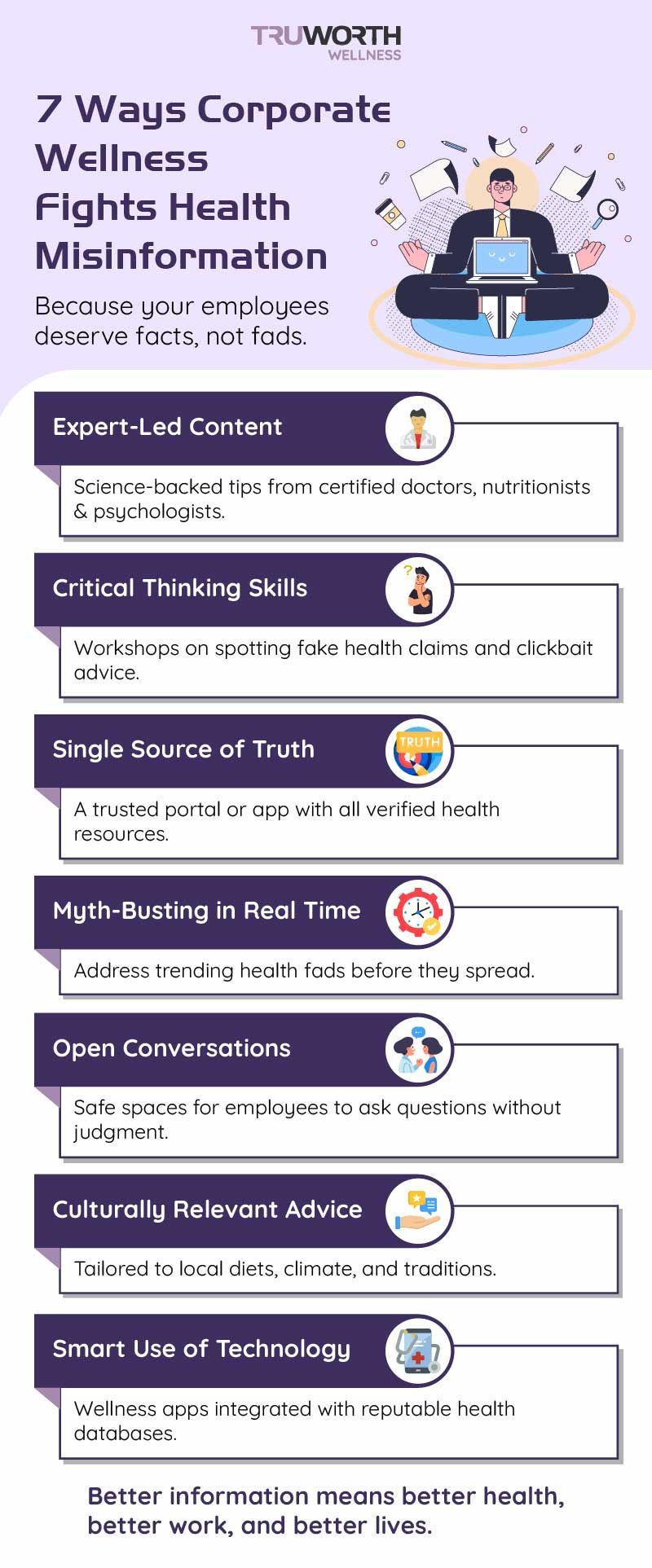How Corporate Wellness Fights Health Misinformation?

Do you agree? Endless scrolling, quick fixes, and “expert” influencers, health misinformation spreads faster than the truth. One catchy headline or a viral video can convince people to try unverified diets, extreme fitness trends, or risky supplements. While these myths are everywhere, they’re not harmless—they can affect workplace wellbeing, increase sick leaves, and even raise healthcare costs for organizations.
The workplace, however, can be a powerful line of defense. Corporate wellness programs, when thoughtfully designed, can help employees cut through the noise and rely on credible, science-backed information for their health decisions. This isn’t just about sending a monthly newsletter—it’s about creating a culture of informed wellbeing.
Why Health Misinformation is a Workplace Issue?
It might seem like an employee’s health choices are personal, but misinformation often leads to consequences that spill into the workplace. For example:
- An employee follows a crash diet and experiences fatigue, affecting productivity.
- Someone skips vaccines due to false information, increasing the risk of illness spread in teams.
- Workers adopt extreme workout routines from social media, leading to injuries and absenteeism.
When health myths go unaddressed, they don’t just harm individuals; they affect teams, budgets, and morale. That’s why employers have a vested interest in being part of the solution.

How Corporate Wellness Can Fight Health Misinformation?
1. Providing Science-Backed, Expert-Led Content
Employees trust their employer more than random social media posts if the information comes from credible sources. Wellness programs can work with certified nutritionists, doctors, mental health experts, and fitness coaches to create content that is accurate, practical, and easy to understand.
Example: Weekly “Myth vs. Fact” posts on the company’s wellness portal or app.
2. Teaching Employees to Think Critically About Health Claims
Fighting misinformation isn’t just about telling people what’s wrong—it’s about helping them spot red flags themselves. Workshops on fact-checking, understanding credible sources, and recognizing clickbait headlines can empower employees to make informed health choices, both at work and at home.
Tip: Use real examples of viral trends and show how to verify their claims.
3. Creating a ‘Single Source of Truth’ for Health Information
Many employees turn to Google for answers, but search results aren’t always reliable. A corporate wellness program can maintain an internal hub or app section with vetted resources, FAQs, and expert articles. This way, employees always know where to find safe, relevant, and updated information.
4. Addressing Myths Before They Spread
A proactive approach is more effective than damage control. Wellness teams can monitor trending fads—like extreme detoxes, miracle supplements, or “no-carb forever” diets—and quickly share balanced, science-based perspectives before misinformation gains momentum in the workplace.
5. Encouraging Open, Judgment-Free Conversations
Simply telling employees “you’re wrong” about a health belief rarely works. Instead, wellness programs can create safe spaces—like lunch-and-learn sessions, anonymous Q&As, or live chats with experts—where people can ask questions without feeling embarrassed or judged. This builds trust and keeps dialogue open.
6. Making Content Culturally Relevant
Generic health advice often ignores local diets, climate, and traditions. This gap is exactly where misinformation thrives—when people feel the “official” advice doesn’t apply to them. By tailoring health content to local realities (like Indian food habits, festivals, and climate), wellness programs can make credible advice more relatable and reduce the appeal of unverified alternatives.
7. Using Technology Responsibly
Corporate wellness apps and platforms can integrate with trusted health databases, deliver micro-learning modules, and send timely reminders. Technology ensures that accurate information is always accessible, but it must be paired with expert oversight to avoid simply becoming another content feed that might get ignored.

The Bigger Impact: Beyond Stopping Myths
Fighting misinformation isn’t just about saying “don’t believe that”—it’s about creating a healthier, more informed workforce. Over time, this leads to:
- Better Health Outcomes – Employees follow safe, evidence-based practices.
- Higher Productivity – Fewer sick days, less fatigue, and more energy at work.
- Lower Healthcare Costs – Prevention is always more affordable than treatment.
- Stronger Trust – Employees see the employer as a partner in their well-being.
When employees know their workplace is a trusted source of health knowledge, they’re more likely to engage in wellness activities, seek help early, and share accurate information with their peers and families.
Action Steps for Employers
If your organization wants to actively combat health misinformation, start here:
- Audit Your Current Wellness Communications – Check if all advice is expert-reviewed.
- Build a Panel of Trusted Experts – Nutritionists, doctors, physiotherapists, psychologists.
- Use Multiple Formats – Mix infographics, videos, articles, and live sessions.
- Measure Impact – Track engagement, knowledge improvement, and health outcomes.
- Stay Agile – Update resources regularly to match new trends and research.
Conclusion
Health misinformation is more than just an internet nuisance—it’s a workplace challenge. Corporate wellness programs have the tools, trust, and reach to change the narrative. By combining expert guidance, cultural relevance, and open communication, organizations can ensure that employees get the facts they need to make safe, healthy choices.
When the workplace becomes a reliable health guide, it doesn’t just prevent misinformation—it builds a culture where wellbeing thrives.
At Truworth Wellness, we help organizations become trusted health authorities for their employees. Our expert-led, culturally relevant wellness programs provide accurate, engaging, and actionable health content—backed by science, not trends. Whether it’s myth-busting workshops, personalized health coaching, or a dedicated wellness app, we ensure your workforce gets the right information at the right time. Let’s build a healthier, better-informed workplace together.
